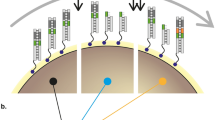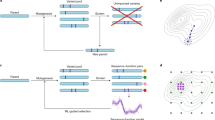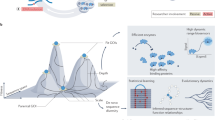Abstract
Directed evolution emulates the process of natural selection to produce proteins with improved or altered functions. These approaches have proven to be very powerful but are technically challenging and particularly time and resource intensive. To bypass these limitations, we constructed a system to perform the entire process of directed evolution in silico. We employed iterative computational cycles of mutation and evaluation to predict mutations that confer high-affinity binding activities for DNA and RNA to an initial de novo designed protein with no inherent function. Beneficial mutations revealed modes of nucleic acid recognition not previously observed in natural proteins, highlighting the ability of computational directed evolution to access new molecular functions. Furthermore, the process by which new functions were obtained closely resembles natural evolution and can provide insights into the contributions of mutation rate, population size and selective pressure on functionalization of macromolecules in nature.

This is a preview of subscription content, access via your institution
Access options
Access Nature and 54 other Nature Portfolio journals
Get Nature+, our best-value online-access subscription
$29.99 / 30 days
cancel any time
Subscribe to this journal
Receive 12 print issues and online access
$259.00 per year
only $21.58 per issue
Buy this article
- Purchase on Springer Link
- Instant access to full article PDF
Prices may be subject to local taxes which are calculated during checkout






Similar content being viewed by others
Data availability
The authors declare that the data supporting the findings of this study are available within the paper and its supplementary information files. The structural coordinates for DHR8 are available at the Protein Data Bank (PDB) under accession 5CWF. DP-Bind is available at http://lcg.rit.albany.edu/dp-bind/Source data are provided with this paper.
Code availability
Proseeker is available for download via GitHub (https://github.com/EvolveWithProseeker/Proseeker). The software package was initially produced in MATLAB (v.r2017b) before porting to other languages with a final optimized Python3 version made available.
Reference
Arnold, F. H. Innovation by evolution: bringing new chemistry to life (Nobel lecture). Angew. Chem. Int. Ed. Engl. 58, 14420–14426 (2019).
Wang, Y. et al. Directed evolution: methodologies and applications. Chem. Rev. https://doi.org/10.1021/acs.chemrev.1c00260 (2021).
Filipovska, A. & Rackham, O. Building a parallel metabolism within the cell. ACS Chem. Biol. 3, 51–63 (2008).
Packer, M. S. & Liu, D. R. Methods for the directed evolution of proteins. Nat. Rev. Genet. 16, 379–394 (2015).
Wrenbeck, E. E., Faber, M. S. & Whitehead, T. A. Deep sequencing methods for protein engineering and design. Curr. Opin. Struct. Biol. 45, 36–44 (2017).
Chandrasegaran, S. & Carroll, D. Origins of programmable nucleases for genome engineering. J. Mol. Biol. 428, 963–989 (2016).
Pickar-Oliver, A. & Gersbach, C. A. The next generation of CRISPR–Cas technologies and applications. Nat. Rev. Mol. Cell Biol. 20, 490–507 (2019).
Moore, R., Chandrahas, A. & Bleris, L. Transcription activator-like effectors: a toolkit for synthetic biology. ACS Synth. Biol. 3, 708–716 (2014).
Corley, M., Burns, M. C. & Yeo, G. W. How RNA-binding proteins interact with RNA: molecules and mechanisms. Mol. Cell 78, 9–29 (2020).
Hall, T. M. T. De-coding and re-coding RNA recognition by PUF and PPR repeat proteins. Curr. Opin. Struct. Biol. 36, 116–121 (2016).
Filipovska, A. & Rackham, O. Designer RNA-binding proteins: new tools for manipulating the transcriptome. RNA Biol. 8, 978–983 (2011).
Filipovska, A., Razif, M. F. M., Nygård, K. K. A. & Rackham, O. A universal code for RNA recognition by PUF proteins. Nat. Chem. Biol. 7, 425–427 (2011).
Brunette, T. J. et al. Exploring the repeat protein universe through computational protein design. Nature 528, 580–584 (2015).
Anfinsen, C. B. Principles that govern the folding of protein chains. Science 181, 223–230 (1973).
Kawashima, S. et al. AAindex: amino acid index database, progress report 2008. Nucleic Acids Res. 36, D202–D205 (2008).
Filipovska, A. & Rackham, O. Modular recognition of nucleic acids by PUF, TALE and PPR proteins. Mol. Biosyst. 8, 699–708 (2012).
Coquille, S. et al. An artificial PPR scaffold for programmable RNA recognition. Nat. Commun. 5, 5729 (2014).
Spåhr, H. et al. Modular ssDNA binding and inhibition of telomerase activity by designer PPR proteins. Nat. Commun. 9, 2212 (2018).
Patel, P. H. & Loeb, L. A. DNA polymerase active site is highly mutable: evolutionary consequences. Proc. Natl Acad. Sci. USA 97, 5095–5100 (2000).
Rogozin, I. B. & Pavlov, Y. I. Theoretical analysis of mutation hotspots and their DNA sequence context specificity. Mutat. Res. 544, 65–85 (2003).
Starr, T. N. & Thornton, J. W. Epistasis in protein evolution. Protein Sci. 25, 1204–1218 (2016).
Helling, R. et al. The designability of protein structures. J. Mol. Graph. Model. 19, 157–167 (2001).
Hwang, S., Gou, Z. & Kuznetsov, I. B. DP-Bind: a web server for sequence-based prediction of DNA-binding residues in DNA-binding proteins. Bioinformatics 23, 634–636 (2007).
Michnick, S. W., Remy, I., Campbell-Valois, F. X., Vallée-Bélisle, A. & Pelletier, J. N. Detection of protein–protein interactions by protein fragment complementation strategies. Methods Enzymol. 328, 208–230 (2000).
Codling, E. A., Plank, M. J. & Benhamou, S. Random walk models in biology. J. R. Soc. Interface 5, 813–834 (2008).
Soskine, M. & Tawfik, D. S. Mutational effects and the evolution of new protein functions. Nat. Rev. Genet. 11, 572–582 (2010).
Ren, C., Wen, X., Mencius, J. & Quan, S. Selection and screening strategies in directed evolution to improve protein stability. Bioresour. Bioprocess. 6, 53 (2019).
Cobb, R. E., Chao, R. & Zhao, H. Directed evolution: past, present, and future. Am. Inst. Chem. Eng. J. 59, 1432–1440 (2013).
Chen, K. & Arnold, F. H. Engineering new catalytic activities in enzymes. Nat. Catal. 3, 203–213 (2020).
Scott, L. H., Mathews, J. C., Filipovska, A. & Rackham, O. in Methods in Enzymology Vol. 633 (ed. Shukla, A. K.) 231–250 (Academic Press, 2020).
Rix, G. et al. Scalable continuous evolution for the generation of diverse enzyme variants encompassing promiscuous activities. Nat. Commun. 11, 5644 (2020).
Esvelt, K. M., Carlson, J. C. & Liu, D. R. A system for the continuous directed evolution of biomolecules. Nature 472, 499–503 (2011).
Crook, N. et al. In vivo continuous evolution of genes and pathways in yeast. Nat. Commun. 7, 13051 (2016).
Wittmann, B. J., Johnston, K. E., Wu, Z. & Arnold, F. H. Advances in machine learning for directed evolution. Curr. Opin. Struct. Biol. 69, 11–18 (2021).
Bedbrook, C. N. et al. Machine learning-guided channelrhodopsin engineering enables minimally invasive optogenetics. Nat. Methods 16, 1176–1184 (2019).
Wu, Z., Kan, S. B. J., Lewis, R. D., Wittmann, B. J. & Arnold, F. H. Machine learning-assisted directed protein evolution with combinatorial libraries. Proc. Natl Acad. Sci. USA 116, 8852–8858 (2019).
Saito, Y. et al. Machine-learning-guided mutagenesis for directed evolution of fluorescent proteins. ACS Synth. Biol. 7, 2014–2022 (2018).
Cadet, F. et al. A machine learning approach for reliable prediction of amino acid interactions and its application in the directed evolution of enantioselective enzymes. Sci. Rep. 8, 16757 (2018).
Alley, E. C., Khimulya, G., Biswas, S., AlQuraishi, M. & Church, G. M. Unified rational protein engineering with sequence-based deep representation learning. Nat. Methods 16, 1315–1322 (2019).
Huang, P.-S., Boyken, S. E. & Baker, D. The coming of age of de novo protein design. Nature 537, 320–327 (2016).
Koga, N. et al. Principles for designing ideal protein structures. Nature 491, 222–227 (2012).
Vorobieva, A. A. et al. De novo design of transmembrane β barrels. Science 371, eabc8182 (2021).
Shen, H. et al. De novo design of self-assembling helical protein filaments. Science 362, 705–709 (2018).
Cao, L. et al. De novo design of picomolar SARS-CoV-2 miniprotein inhibitors. Science 370, 426–431 (2020).
Butterfield, G. L. et al. Evolution of a designed protein assembly encapsulating its own RNA genome. Nature 552, 415–420 (2017).
Broom, A. et al. Ensemble-based enzyme design can recapitulate the effects of laboratory directed evolution in silico. Nat. Commun. 11, 4808 (2020).
Miles, A. J., Ramalli, S. G. & Wallace, B. A. DichroWeb, a website for calculating protein secondary structure from circular dichroism spectroscopic data. Protein Soc. https://doi.org/10.1002/pro.4153 (2021).
Acknowledgements
We thank the anonymous reviewers for their insightful suggestions and K. Young for assistance with circular dichroism experiments. Work in our laboratories is supported by fellowships from the National Health and Medical Research Council (APP1154646, to A.F., and APP1154932, to O.R.) and an Australian Research Council Centre of Excellence (CE200100029, to A.F. and O.R.). S.A.R. and B.P. are supported by Australian Postgraduate Awards. This work was supported by resources provided by the Pawsey Supercomputing Centre with funding from the Australian Government and the Government of Western Australia.
Author information
Authors and Affiliations
Contributions
S.A.R., A.F. and O.R. designed the research. S.A.R. wrote the computer code and carried out the computational and biological experiments. B.P. and M.B. carried out biological experiments. S.A.R., A.F. and O.R. analyzed the experiments. A.F. and O.R. supervised the research. S.A.R. and O.R. wrote the manuscript, with contributions from all authors, and all authors edited the manuscript.
Corresponding author
Ethics declarations
Competing interests
The authors declare no competing interests.
Peer review
Peer review information
Nature Chemical Biology thanks the anonymous reviewers for their contribution to the peer review of this work.
Additional information
Publisher’s note Springer Nature remains neutral with regard to jurisdictional claims in published maps and institutional affiliations.
Extended data
Extended Data Fig. 1 Sequences of synthetically evolved proteins (SEPROs).
a, SEPRO1-9 and their progenitor protein DHR8. SEPRO1-5 were chosen from the productive phase of the synthetic evolution cycle, SEPRO6-9 were chosen from earlier generations. SEPRO1-3 were found to bind nucleic acids. b, Comparison of nucleic acid binding SEPROs and PPRs (designated by their UniProt IDs). c, The variant masking scheme used in the experiment shown in Fig. 6b.
Extended Data Fig. 2 Electrophoretic mobility shift assay of SEPRO5.
Incubation of SEPRO5 with a selection of RNA and DNA homopolymer probes.
Extended Data Fig. 3 Characterization of SEPRO2 by protein titration EMSAs.
a, Binding of SEPRO2 to poly(G) ssRNA, b, ssDNA and c, poly(C/G) dsDNA was assessed. Low apparent binding of C/G dsDNA by SEPRO2 may be due to the presence of a small amount of free poly(G) ssDNA probe in these reactions, or an ability of these proteins to invade dsDNA duplexes (Extended Data Fig. 3c). d, Quantitation of SEPRO2 binding to poly(G) ssRNA and ssDNA revealed Kd values of 9.0×10−8 and 1.8×10−7, respectively.
Extended Data Fig. 4 SEPROs from early stages of evolution have not yet attained functionality.
a, Protein sequences were selected from generations 4 and 10 of the directed evolution process (designated SEPRO6-9). The mean, range and standard deviation (SD) for each run are shown. b-e, Electrophoretic mobility shift assays testing RNA, ssDNA and dsDNA-binding of SEPRO6-9.
Extended Data Fig. 5 Bacterial three-hybrid system expression cassettes.
Fusion proteins are expressed from a pET24(+) backbone, allowing IPTG inducible protein expression in T7 RNA polymerase expressing Escherichia coli strains. Hybrid RNAs are constitutively expressed from an rrnB promoter within a p15A plasmid backbone.
Extended Data Fig. 6 Neutral mutations in computational evolution.
Instances where previously neutral mutations eventually contributed to the development of new binding sites are identified where the Levenshtein distance between progeny sequences and their progenitor is greater than 2 (the number of new mutations introduced in each generation). Windows of relevant protein sequence are shown as examples in specific cases.
Extended Data Fig. 7 Dynamic residue similarity.
a, Dynamic residue similarity (DRS) map showing number of residues to which each residue is considered similar to at each similarity level with unique, dominant and effective outliers shown (the data from this panel are provided in a tabular form in Supplementary Table 1). b, Similarity pathing of methionine and cystine from the highest two similarity levels. c, Optimized PPR library residue frequency heatmap. d, Less diverse PPR library residue frequency heatmap.
Extended Data Fig. 8 Protein characterization.
a, Purified proteins were assessed by SDS-PAGE followed by Coomassie blue staining. b, Circular dichroism spectrum for SEPRO2. Experimentally determined secondary structure proportions are compared with those predicted using PSIPRED. c, Proteins do not bind fluorescein dye alone, as determined using electrophoretic mobility shift assays of SEPRO2 and SEPRO6.
Supplementary information
Supplementary Information
Supplementary Notes 1–3, Tables 1–3 and description of datasets.
Supplementary Dataset 1
Amino acid descriptors used to assess protein elements in Proseeker.
Supplementary Dataset 2
Scoring of an example assessment window in Proseeker. Related to Supplementary Note 2.
Source data
Source Data Fig. 4
Unprocessed EMSAs for Fig. 4.
Source Data Extended Data Fig. 2
Unprocessed EMSAs for Extended Data Fig. 2.
Source Data Extended Data Fig. 3
Unprocessed EMSAs for Extended Data Fig. 3.
Source Data Extended Data Fig. 4
Unprocessed EMSAs for Extended Data Fig. 4.
Source Data Extended Data Fig. 8
Unprocessed Coomassie-stained protein gel and EMSA for Extended Data Fig. 8.
Rights and permissions
About this article
Cite this article
Raven, S.A., Payne, B., Bruce, M. et al. In silico evolution of nucleic acid-binding proteins from a nonfunctional scaffold. Nat Chem Biol 18, 403–411 (2022). https://doi.org/10.1038/s41589-022-00967-y
Received:
Accepted:
Published:
Issue Date:
DOI: https://doi.org/10.1038/s41589-022-00967-y



